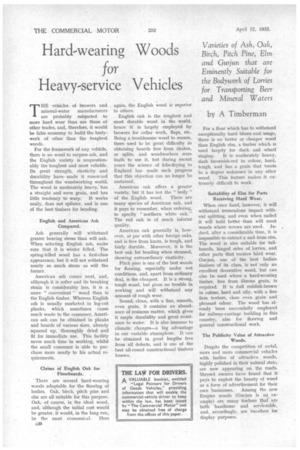Hard-wearing Woods for Heavy-service Vehicles
Page 52

If you've noticed an error in this article please click here to report it so we can fix it.
by A Timbermart
THE vehicles of brewers and mineral-water manufacturers are probably subjected to more hard wear than are those of other trades, and, therefore, it would be false economy to build the bodywork of other than the toughest woods.
For the framework of any vehicle, there is no wood to surpass ash, and the English variety is unquestionably the toughest and most reliable. Its great strength, elasticity and durability have made it renowaed throughout the woodworking world. The wood is moderately heavy, has a straight and even grain, and has little tendency to warp: It works easily, does not splinter, and is one of the best timbers for bending.
English and American Ash Compared.
Ash generally will withstand greater bearing stress than will oak. When selecting English ash, make sure that it is winter felled. The spring-felled wood has a first-class appearance, but it will not withstand nearly so much stress as will the former.
American ash comes next, and, although it is softer and its breaking strain is considerably less, it is a more " convenient" wood than is the English timber. Whereas English ash is usually marketed in log-cut planks, which sometimes cause much waste to the consumer, American ash can be obtained in planks and boards of various sizes, already squared up, thoroughly dried and fit for immediate use. This facility saves much time in working, whilst the small consumer is able to purchase more nearly to his actual requirements.
Claims of English Oak for Floorboards.
There are several hard-wearing woods adaptable for the flooring of bodies. Oak, birch, pitch pine and elm are all suitable for this purpose. Oak, of course, is the ideal wood, and, although the initial cost would be greater, it would, in the long run, be the most economical. Here c30 again, the English wood is superior to others.
English oak is the toughest and most durable wood in the world, hence it is largely employed by brewers for cellar work, flaps, etc. Being a troublesome wood to season, there used to be great difficulty in obtaining boards free from shakes, or splits, and woodworkers were loath to use it, but during recent years the science of kiln-drying in England has made such progress that this objection can no longer be sustained.
American oak offers a greater variety, but it has not the " body " of the English wood. There are many species of American oak, and it pays to remember, when ordering, to specify "northern white oak." The red oak is of much inferior quality.
American oak generally is, however, at par with other foreign oaks, and is free from knots, is tough, and fairly durable. Moreover, it is the best oak for bending when steamed, showing extraordinary elasticity.
Pitch pine is one of the best woods for flooring, especially under wet conditions, and, apart from ordinary deal, is the cheapest. It is a strong, tough wood, but gives no trouble in working and will withstand any amount of rough wear.
Sound, clean, with a fine, smooth, even grain, it contains an abundance of resinous matter, which gives it ample durability and great resistance to water. It is also immune to climatic changes—a big advantage in our variable atmosphere. It can be obtained in great lengths free from all defects, and is one of the best all-round constructional timbers known. For a floor which has to withstand exceptionally hard blows and usage, there is no better or cheaper wood than English elm, a timber which is used largely for dock and wharf
staging. It is moderately heavy, dark brownish-red in colour, hard, tough, and has a grain that twists to a degree unknown in any other
wood. This feature makes it extremely difficult to work.
Suitability of Elm for Parts Receiving Hard Wear.
When once fixed, however, it will withstand tremendous impact without splitting, and even when nailed it will hold better than will -most woods where screws are used. InAced, after a considerable time, it is impossible to extract a nail from elm. The wood is also suitable for tailboards, hinged sides of lorries, and other parts that receive hard wear. Gurjun, one of • the best Indian timbers of its class, is not only an excellent decorative wood, but can also be used where a hard-wearing timber, free from fibrous grain, is required. It is dull reddish-brown in colour, hard and oily, with a fine firm texture, close even grain and pleasant odour. The wood has already been successfully employed for railway-carriage building in this country, also for flooring and general constructional work.
The Publicity Value of Attractive Woods.
Despite the competition of metal, more and more commercial vehicles with bodies of attractive woods, highly polished in their natural state, are now appearing on the roads. Shrewd owners have found that it pays to exploit the beauty of wood as a form of advertisement for their own businesses. Among the new Empire woods (Gurjun is an example) are many timbers that are both handsome and serviceable, and, aCcordingly, are excellent for display purposes.












































































































